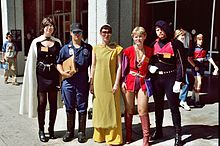Creative anachronists and those who enjoy cosplay put great effort into creating more-or-less authentic costumes. They usually do not weave their own cloth (much less raise the sheep, shear the sheep, and spin the wool), and dying their own cloth is not common, but the more authentically-minded sew by hand rather than by by machine.

(Of course a lot of them buy patterns, in their size, and use the pieces of tissue to cut out pieces of cloth in the right shape, but there are limits to how heavy-duty someone wants to be.)

If one is going to become all authentic about medieval costumes, one of the first decisions is to choose the era one is trying to reproduce. For both men and women, throughout the Middle Ages, the basic unit of clothing was a tunic, essentially a long-sleeved T-shirt, shorter for the men, longer for the women, as seen in the medieval drawing below. A long rectangular cloak, generally with a hood, went over this in cooler weather. But this simple design was greatly varied depending on time and place.
Classical antiquity had had very simple clothing, a lot of it basically pieces of cloth just wrapped, tied, and pinned around the body. Early medieval clothing seems to have been equally simple, although Germanic men adopted trousers, which the Romans initially found both effeminate and hilarious.
As the Middle Ages went on, clothing became more elaborate. Elegant women wore dresses cut on the bias, which gave their clothing stretch, allowing their clothes to fit more closely to their bodies. These elegant dresses did not have zippers or other fasteners (zippers are a nineteenth-century invention), so the woman had to wiggle her way in. Sleeves were basted on separately, every morning.
Even with fairly simple tunics above and socks or stockings below (no tights), an outfit could be accessorized with brooches, bracelets, necklaces, sashes, and fancy belt buckles. These were worn by both sexes. The image below is a modern reproduction of a Frankish belt buckle.
A big advance in the thirteenth century was the adoption of buttons. Originally they were merely decorative, but quickly women realized they could be used with loops as closings for one's clothes, allowing even more tight-fitting outfits. Lots of buttons (which were expensive, usually mother-of-pearl or ceramic) was a sign of luxury.
Toward the end of the Middle Ages women started wearing elaborate head dresses, again as signs of wealth and luxury. Keeping one's clothing fresh and unstained, especially if it was white, was also a sign of luxury in an era with neither dry cleaning nor washing machines.
In the post-medieval period, clothing became even more elaborate for those who could afford it. Those huge white ruffled collars one sees in early modern Dutch paintings were certainly nothing that ordinary working people could afford or manage.

At the court of Louis XIV in France, clothing was by far the biggest expense for the aristocrats at court trying to impress each other.
© C. Dale Brittain 2021
For more on clothing and other aspects of life in the Middle Ages, see my ebook, Positively Medieval, available from Amazon. Also available in paperback1



No comments:
Post a Comment